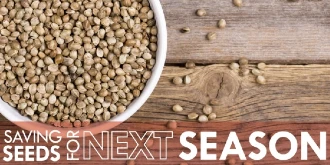The Grounds Guys explain how to save seeds for next season's garden success.
|
Seed saving is not at the top of everyone’s list anymore, because seeds and seedlings are easily available at the local nursery. However, saving seeds from year to year is a great way to guarantee that your favorite plant will be around again next year. You may find it easier to do this, and you never know when a seed company might choose to discontinue the plant you love.

Not every plant is a good candidate for seed saving. It’s important to know the different types of plants and which seeds are worth saving for your intended purpose.
Heirlooms are the best plants for seed saving. These are self-pollinated and will produce a plant that looks exactly like the parent. This is the main type of plants that people save the seeds from with the intention to grow an identical plant the next year.
Hybrids will grow into a variety of plants that will have some traits of either or both parents. Most plants being sold in stores are like this and will not produce an identical plant. Seed saving is not usually necessary for these plants, unless you are very open to new types of plants.
Here is a short list some of the plants that are good for seed saving:
- Beans
- Chicory
- Endive
- Lettuce
- Peas
- Tomatoes
- Cleome
- Foxgloves
- Hollyhock
- Nasturtium
- Sweet Pea
- Zinnia
Be sure to choose the best quality plants to save seeds from. Consider these factors: disease resistance, great flavor, vigor and productivity. You want to make sure all of these things are the best they can be, because next year’s plant will be the same as this one.
You can choose to harvest the seeds at one of two times:
When the seed pods have dried on the plant, such as in flowers, beans, lettuce, etc. Watch the pods as they begin to turn brown. A lot of times, the seed pods will open and disperse by themselves. You can put small bags over the pod when it looks like it’s about to pop and catch the seeds or you can pull the plant right before it’s completely dry and store it upside down in a paper bag.
When the vegetable is fully ripe. The vegetables will be well past ready to be eaten when the seeds are ready. For most vegetables, you can just remove the seeds and dry them.
- Make sure the seeds are completely dry, so they don’t rot or mold in storage.
- Store them in a paper envelope, and label it with the variety and year.
- Place the envelopes in an airtight container (i.e. a canning jar).
- Store in a dark, cool, dry place.
The viability of the seeds will decrease over time. Most seeds should be used within at least three years, while some, such as parsley, onion and sweet corn, should be used within a year.
Though seed saving is perfect for some varieties of plants, you shouldn’t rely on it for your entire garden. You may do it for fun or out of necessity. Either way, it can be a great way to ensure that you keep your beautiful heirloom plants around year after year.